Radiant Historia Review
Posted by CmdrKing on March 12, 2011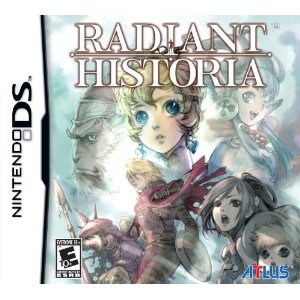 *Platform: Nintendo DS
*Platform: Nintendo DS
*Publisher: Atlus
*Developer: Atlus
*Release Date: February 2011
While gaming as a medium has a more favorable relationship with sequels than cinema or literature, it’s still all too susceptible to the same pitfalls movies suffer in terms of genre mutation and imitation. That is, all too often developers, eager to cash in on the big new things and generally following the leader, will take elements from bigger, more successful franchises without considering how they function within their work, or even the genre their work is in. Sure, you can still find older style games, but they’re almost like time capsules, thing untouched from an earlier era with no change, making the same mistakes. But once in a great while, you find a game, movie, whatever where the creators truly loved an older era. They seek not merely to replicate the works of times past, but instead to look at them critically, see what made them work, what they loved about them, and assemble them into a better, stronger whole. Radiant Historia is one of those games, and you should be playing it.
The artwork behind Radiant Historia is different. Our hero is known throughout the game for his red armor, so you’d think there was a strong use of vivid color and outlandish designs (he’s a spy after all!) and… there’s not. Even stand out, primary colors are quiet elements, and while the outfits are distinctive enough to work in a sprite-based game like RH, the designs are never over the top. Raynie shows generous amounts of skin, but never to the point of being scantily clad. Marco has superfluous, cat-like ears on his helmet, but dresses in earth tones and has well-insulated armor. While the character portraits used in the game have just one expression, so you don’t see it as much, even the facial designs are soft, with a sort of innocence to them. The only odd thing about it all is that Stocke has the weirdest expression in his portraits. It’s not truly neutral, but I can’t really peg it as any real emotion either. He also looks quite a bit older than he apparently is, but that’s pretty common in this game for whatever reason. Maybe it’s the somber style in use. The sprite work occupies a middle ground I’m having trouble pinning down. It uses the anime-style proportions of Chrono Trigger or most modern sprite games, but lacks the expressiveness of the latter. However, there are rather obviously more frames of animation than you’d find in the 16 bit era, even if the range of motion and expression is fairly similar.
Yoko Shimomura. Where I to write reviews merely for myself, and not for a theoretical someone else, I could just end any commentary on the music there and go buy the game. But for those not familiar with her work in Kingdom Hearts, you may instead know her as the one behind Legend of Mana’s OST, rightly considered one of the strongest OSTs to ever come out of a video game. I’m not going to claim RH is on that level, but it is her strongest work since then. The music here takes inspiration from across her body of work, with perky tracks that could be inserted seamlessly into Kingdom Hearts, location themes that sound like something from Mario and Luigi, and of course string-heavy emotional themes that rival their counterparts from the gold standard, LoM. There’s not a lot else to say. RH doesn’t have voice work, unsurprising in a DS game, but all things considered I think I prefer it that way. Not so much for the nostalgia of it, but because when you look at the game as a whole, it’s obvious a lot of work, time, and money went into making this game, and I find it hard to believe that the voice work would have that level of detail and quality behind it during the localization process.
Radiant Historia uses a turn based battle system… or more accurately, Radiant Historia uses a battle system which is the first in a long time to make logical advancements on classic turn based systems. The core seems to be comparable to FFX’s turn calculation, though of course it can be hard to tell what’s going on under the hood. But two layers have been added on top of this. The first is a universal turn change command, wherein the active character can freely exchange their turn with enemies or allies further down on the visible turn gauge. The benefits of changing turns with an ally are obvious, but why would you want to give enemies the turn before you? Primarily because of the second mechanic, the combo gauge. Like Valkyrie Profile games, in RH as you add hits to the current attack sequence (which runs until you stop attacking a given enemy) the higher damage each subsequent hit deals. Unlike Valkyrie Profile, the value of even two or three hits on the gauge is noticeable, and by 15 or so hits damage is nearly double its baseline value. But what if you want to attack more than one enemy? No problem! Radiant Historia places enemies on a 3×3 grid, and while relatively few skills hit multiple grids, every characters has at least one skill dedicated to moving enemies around the grid by pushing, grabbing, or shoving them to the side. This system is also used to knock enemies into each other, giving the player a key strategic advantage when combined with the combo gauge. Even without this element, enemies deal and receive less physical damage the further back along the grid they are, meaning that pulling them forward or pushing them back can be advantageous unto itself.
The skill system is quite straightforward. Each character has an extensive list of abilities they learn as they level up, and each has 4 additional skills each learned by finding a specific hidden item and returning it to an NPC specific to each character. The cast is rounded out by Mana Bursts, skills learned at three specific points in the game which function as the Limit-type skills in the game. You build the Mana Gauge by dealing or receiving damage (bonus points for doing so with a high combo gauge), and while two of the three skills are unique for each character (the first, Turn Break, is exactly what it says) they mostly follow the general guideline of the first being a combo-aid and the second being high end damage, although some characters are stuck in a supporting role.
RH uses visible enemies on the field, in the vein of Mario RPGs where each field enemy is an enemy group on a separate battle screen. However, while enemies walking into your back side gives them the initiative, the player initiative mechanic is a little harder to trigger. You can swing your sword on the field, which rather than initiating battle instead knocks the enemy back and has a chance to stun them, at which point starting battle gives you the initiative. Or, of course, you could just run by them. This is trickier to pull off than it sounds, though, because the knock-back on a sword swing actually takes enemies out of sword range, so there’s a particular timing to hitting them multiple times and scoring the stun. The last element of gameplay is a light puzzling bent, wherein Stocke learns skills throughout the story which allow him to progress past specific roadblocks. These skills are also used to find items in various ways throughout the game, and the final dungeon does throw a few puzzle bits at you, but it’s a fairly minor part of the game.
Stocke is an agent of Special Intelligence (making him somewhere between spy and commando), who is assigned the dangerous task of bringing a scout with vital enemy plans back to his home nation of Alistel. Before the mission, his superior Heiss hands him a book, the White Chronicle, saying that if nothing else it could be a good luck charm. Owing to the critical nature of the mission, which could well end the stagnating war between Alistel and Granorg, Stocke is additionally assigned two subordinates, Raynie and Marco. However, Granorg is somehow perfectly aware not only of the scout’s movements, but of where Stocke will attempt to lead his charge in order to evade the pursuing troops. After the scout is felled by enemy snipers, Stocke and his subordinates find themselves on a bridge, cut off from escape into Alistel by the deadliest warrior on all Granorg. He easily dispatches Raynie and Marco and, finding himself surrounded, Stocke is forced to jump from the bridge into the river below.
At which point he finds himself in Historia, a realm accessed with the White Chronicle. The guardians there tell him two things; that he and he alone can save the world from the desertification that threatens to leave the entire world a lifeless waste, and that the White Chronicle has the power to let him replay portions of time, so long as he has experienced them, and to jump backwards to points at which he made critical decisions. Armed with this power, he thwarts the all too perfect trap of Granorg and makes it back to Alistel with the scout and his critical information intact. However, the soon collapses; the wounds he sustained fleeing the doomed timeline stay with him, as he continues to experience the rewound time even while others do not.
Thus goes the prologue of Radiant Historia. Shortly thereafter, Stocke is presented with a critical choice; to continue working for Heiss, or to join his friend Rosch in forming a new brigade within the army proper. In fact, this decision is so critical it creates two valid timelines, and so Stocke must jump back and forth in time in both the Standard and Alternate history he creates in order to end the war, protect his friends, discover the secrets of how events are so perfectly arrayed against him and every turn, and ulimately save the world from the utter devastation of life within it.
At this stage, you may have noticed that parts of the game sound like a fairly standard RPG plot, while the other could fit seamlessly into say Suikoden. Which of course is probably intentional, given RH’s mission of being a reconstruction of the classic RPG. More interestingly, however, the Standard and Alternate histories each take on one of those two styles and runs with them, while the game as a whole retains the strength of both. A war story which fights for the fate of the world, a classic world-spanning adventure with political undertones, and through it all sharp, poignant writing which cuts straight through to the heart of things, whether in advancing the plot or in emotion, drama, and so forth. But most of all is our hero, Stocke, who brings the sort of pragmatic determination you’d hope for from a spy-slash-commando. He’s far from emotionless, yet knows when to grit his teeth and make the hard choices, while being sharp enough to pick up on subtleties, things people almost blurt out but catch themselves on, and other things heroes normally miss to the great annoyance of the player.
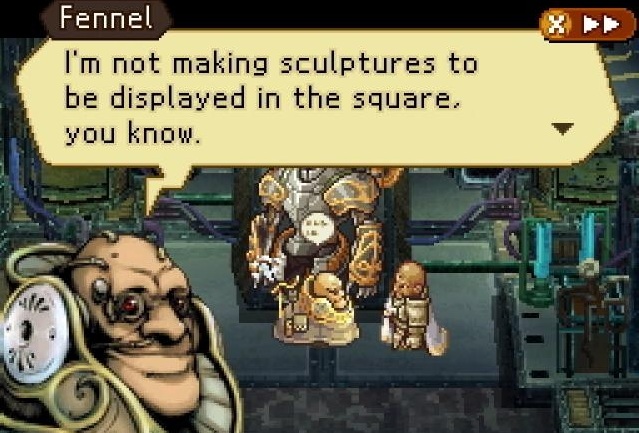
As far as I can tell, he's a disembodied head in a hover-chair. SPOILER!! And the evil mad scientist.
Being a game about time travel, and in particular time travel based on the protagonists own decision making, you might expect a lot of smaller path splits in the game. This is not the case, however, because the game lays out from the very beginning that the world is so close to collapse, history so perilously placed above the maw of disaster, that there’s but one path to saving it. The practical effect of this is that every choice in the game either lets you continue the game (or allows you discover a road block placed by the forces working against you, which requires gaining skills in the alternate timeline) or leads to a bad ending. While these bad endings often take up weeks, months, or in at least one case a year of in-universe time, the game offers you a single scene summarizing how this bad choice destroyed the world before sending you back to the start of the chapter, from which you can generally jump forward to the decision again. While some of the sidequests have bad ends as well, and you can’t time travel to those decisions, on the whole the system is good about not making you replay too many large sections in order to make the right choices, in addition to often making the correct choice fairly obvious from the start anyway.
Radiant Historia makes a number of small missteps, and listing all of them would probably take a replay, because they’re so minor they just don’t stick with you sitting back from the completed game. The only truly major one is those occasions where you really do have to replay sections of the game to get things done, because while you can scene skip (start button!) any time you travel backwards you also erase advancing the world map, which combined with having to go through each area in both timelines (more or less) and a handful of times you simply have to cross an old area as part of the advancing plot, there’s quite a lot of retreading old ground in the game. But even then, it’s definitely not on the order of Suikoden III (if nothing else, if you get through a dungeon and decide you need to restock on items, you can just go to the map and skip the dungeon).
RH is generally pretty friendly for completionist purposes. While some of the sidequests have rather obscure triggers, on the whole simply looking through available towns carefully at the start of each chapter will reveal them. More than that, the game informs you from the outset that there are 236 nodes, so it’s always easy to tell roughly how well you’ve been doing at locating them. I finished the game at a very nearly complete 235/236, with about 31 hours, so don’t expect to blast through RH in a weekend… although honestly, getting that sort of mileage from a DS game is a nice change of pace. In all, though, Radiant Historia does almost everything right. The gameplay takes a bit to get going, the supporting cast isn’t quite as strong as it could be, but the presentation is excellent, there’s plenty of good fights mixed in, plenty of strong storytelling, the final revelations, particularly the epilogue unlocked by completing the 10 character sidequests (6 supporting PCs and 4 major NPCs), are both engaging and emotionally evocative. This is the best game on the DS, and it’d be criminal to miss out on it.
Pros: Well realized visuals, beautiful music, engaging gameplay, moving plot… a complete package.
Cons: Occasional retread issues
WTF?: loligoat
Final Grade: 9/10
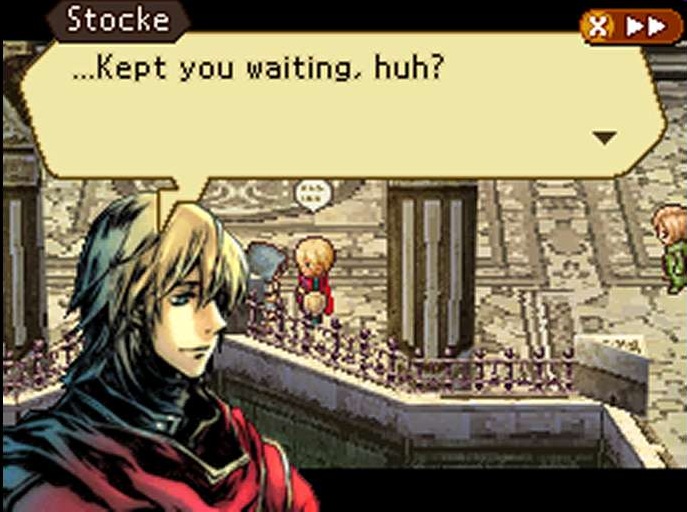
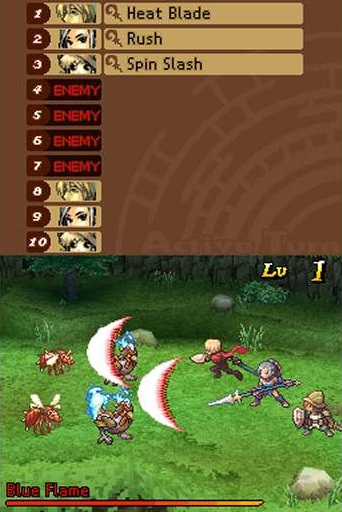
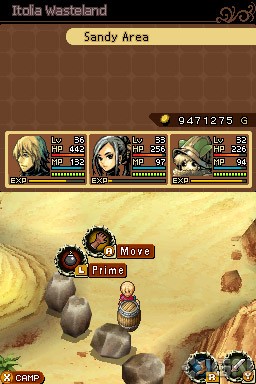
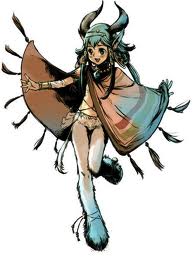
Ooh, this review mentioned quite a few things I hadn’t known about the game that actually make me want to play it even more! The endgame character sidequests and Disembodied Hover Chair Head in particular.
The character sidequests are actually spread throughout the game, but each add an epilogue to the ending with getting them all unlocking the Golden Ending. Basically, if a quest has a Bad End attached, it’s relevant to unlocking the best ending (and it’s awesome to see how these quests can go so catastrophically wrong that they destroy the world! Except for one, where it’s clearly just the outcome being utterly unacceptable to Stocke.)
Add A Comment